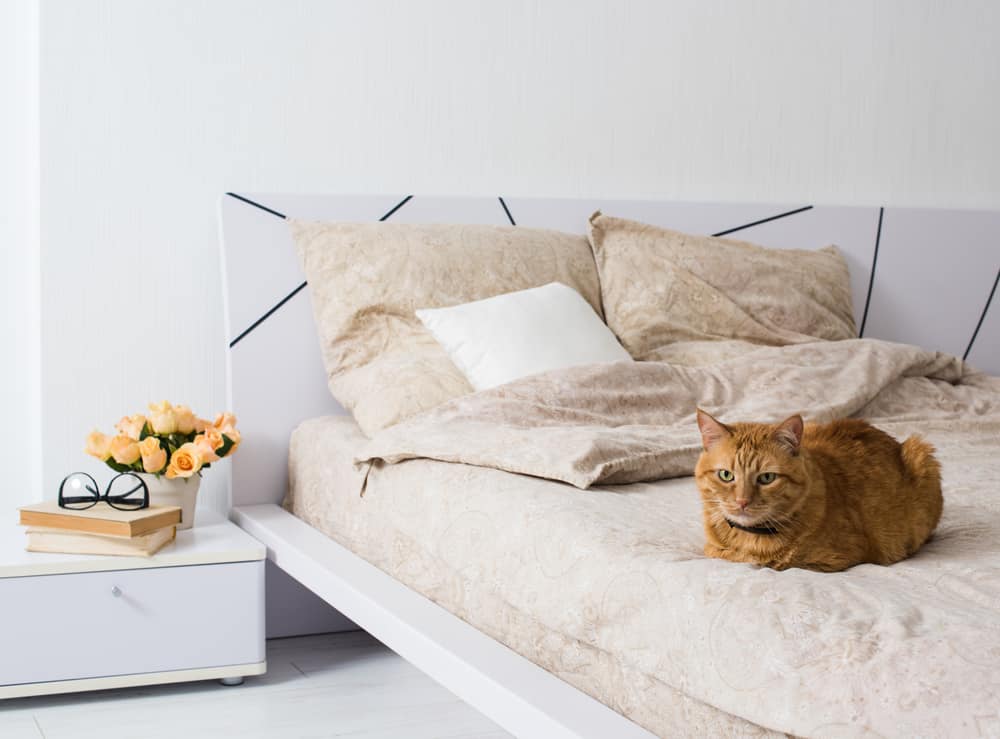How to Keep Your Cat Out of a Room

Curiosity has undoubtedly led your cat into a forbidden room time and time again. We love our fluffy friends, but there are several reasons not to let them in certain rooms. Maybe you want them out of the kitchen because they get on the counters or out of a bedroom because someone’s allergies are acting up.
It may seem impossible to keep your kitty out of certain areas, but that’s not the case. You’ll need plenty of patience to train your cat, but eventually, your hard work will pay off. If you’re not sure where to start, you’ve come to the right place.
Understand Your Cat’s Reasoning
Before you can begin to train your cat, you need to understand what’s causing your cat’s behavior. If your cat keeps going to a room you consistently try to keep them out of, then there’s obviously something they want inside.
Allow your cat to go in there just once so you can observe their behavior. Did they lay down on a specific blanket or pillow, chew on a plant, or lay in the sun?
Whatever they do could be a sign of an underlying problem. If they go to a window, maybe they’re cold and they’re looking for warmth. If they choose a fluffy pillow, they could be experiencing some kind of pain.
Of course, it’s possible that they just like the coziness of the blanket or they want to be in the room because you’re in it. You only need to worry about their behavior if it seems out of the ordinary.
Once you’ve established why your cat insists on being in the room, you can move on to planning out how to train your cat to stay out of it.
Use Positive Training to Keep Your Cat Out of a Room
When it comes to training a cat, positive reinforcement is the only truly successful way to handle it. Positive training focuses on rewarding good behavior instead of punishing bad behavior.
Cats can be standoffish at times, which is why you need to associate yourself with positivity. If you punish your cat, they can eventually associate you with negative behaviors and become nervous around you or scared of you. If your cat associates you with loving pets and treats, they won’t fear you.
Positive training is crucial for naturally skittish cats or for rescue cats who had to endure unpleasant experiences. When training your cat, be compassionate and gentle.
We’ve gathered some of the best positive training techniques for you to try here.
Offer Alternative Options
One form of positive training is to give your cat an alternative. Whatever they’re going after in the forbidden room, try to replicate that item in a room they’re allowed to be in.
For instance, if your cat likes to chew up your houseplants in the bedroom, try growing catnip by another window. Cats usually love catnip more than other houseplants, so they will likely be attracted to it more often.
If your cat loves your pillow, consider sacrificing the pillow and leaving it in a different room. Or buy a similar pillow or cat bed that your cat will enjoy laying on.
Training may be able to stop here. If the alternative option is as good as or better than the thing drawing your cat into the room, they may forget about the original object completely. You’ll need to continue to monitor your cat just to make sure that they don’t revert back to their old ways.
Distract and Reward
If your cat is headed toward a room you don’t want them to go in, you can distract them to prevent them from going inside. Distractions can be making a soft noise to get their attention, offering them a treat, or gently tossing a toy in their direction. Once they’re distracted, offer them a treat to reward the good behavior.
Cats respond well to rewards and it’s the best way to train them. They’ll eventually learn that staying out of the room earns them a treat and the behavior will soon turn into a habit.
Block the Doorway
For incredibly stubborn cats, you may need to block the doorway if they ignore your efforts to keep them out. For bedrooms, it’s easy – just close the door. For open rooms like kitchens and living rooms, however, it may take some extra effort.
Try using gates that are made to keep pets and babies out, or hang up a curtain that you can secure into place with a pin or clothespin. This solution will be a hassle to deal with, but it’s only temporary since it’s just meant to break your cat’s habit of entering that room. Once they start getting used to the idea, you can move on to another tactic, like distracting them or using adverse training methods.
Adverse Training
Adverse training should be saved as a last resort method, as it can easily be misused and cause relationship issues between you and your cat. Adverse training is also called negative training and is highly frowned upon by many pet owners.
However, when used appropriately, adverse training can be highly effective. So, what is it, exactly?
Unhealthy adverse training causes your cat to associate you with negative interactions. If you use negative physical contact to punish such as hitting or swatting, this slowly teaches your cat to associate you with that behavior. Spraying water in their face and making loud sounds to scare them can also cause them to associate you with negative behaviors.
The adverse training methods listed below are harmless and won’t ruin your reputation with your cat. The cat will associate the room with the negative training, so they’ll avoid the room instead of you.
Make the Room Uncomfortable
By uncomfortable, we mean undesirable. If your cat likes the carpet or bedding in a room, do what you can to remove it. Get a new bedspread, redo the flooring, or place a rug on the floor that’s much less comfortable. If your cat is attracted to the sunlight, try using sheer curtains so it’s not as bright and warming.
Many cats don’t like loud or high-pitched sounds, so try playing music that will irritate them or watch TV a little louder than you’d prefer.
You can also play with textures to discourage your cat from staying in the room. If they like to scratch up furniture or lay where they aren’t supposed to, make scratching these objects undesirable. Cats won’t want to scratch a surface that’s sticky, so you can use duct tape, sticky side up, to deter them, or wrap aluminum foil on surfaces. You can even lay the foil on top of what you don’t want them to lay on.
If your cat likes to lay on laundry, keep dirty laundry in a bin with a lid or hang up clean laundry right away. (Or just stuff it in a drawer. That’s easier.)
This method of adverse training works hand-in-hand with offering alternative options for your cat. If you take away what they love in the room and offer them something even better somewhere else, they’ll have no reason to go into the room.
Deploy Strong Scents
Cats don’t like strong smells such as air freshener, body spray, or citrus. Try lighting a candle, spraying cologne, or using an automatic air freshener plug in to keep the room smelling fresh.
You’ll love it, but your cat won’t. The cat won’t associate the scent with you directly, so the chances of your cat starting to stay away from you are very low.
Cat Repellent
There are several forms of cat repellent you can buy at pet stores or find in your refrigerator.
If your cat goes into a room to chew on something, you can use hot sauce to deter the cat from chewing on it. It sounds cruel, but the spice will be a quick lesson and it won’t burn for too long. Just choose a mild sauce and only apply a tiny dab.
There are also cat spray repellents you can spray on furniture, carpet, or doors to keep your cat away. They may have a smell that could repel you, too, so you’ll need to check the ingredient labels to make sure there aren’t any scents that you’ll hate.

Final Thoughts
Contrary to popular belief, it isn’t impossible to train a cat. It’ll take a lot of patience and persistence, but you can train your cat to stay out of a room even if it doesn’t have a door.
Some methods might be annoying to keep up, with like blocking entrances or giving up your favorite blanket just to keep the cat happy, but they’re positive ways to teach your cat what you do and don’t want them to do.




